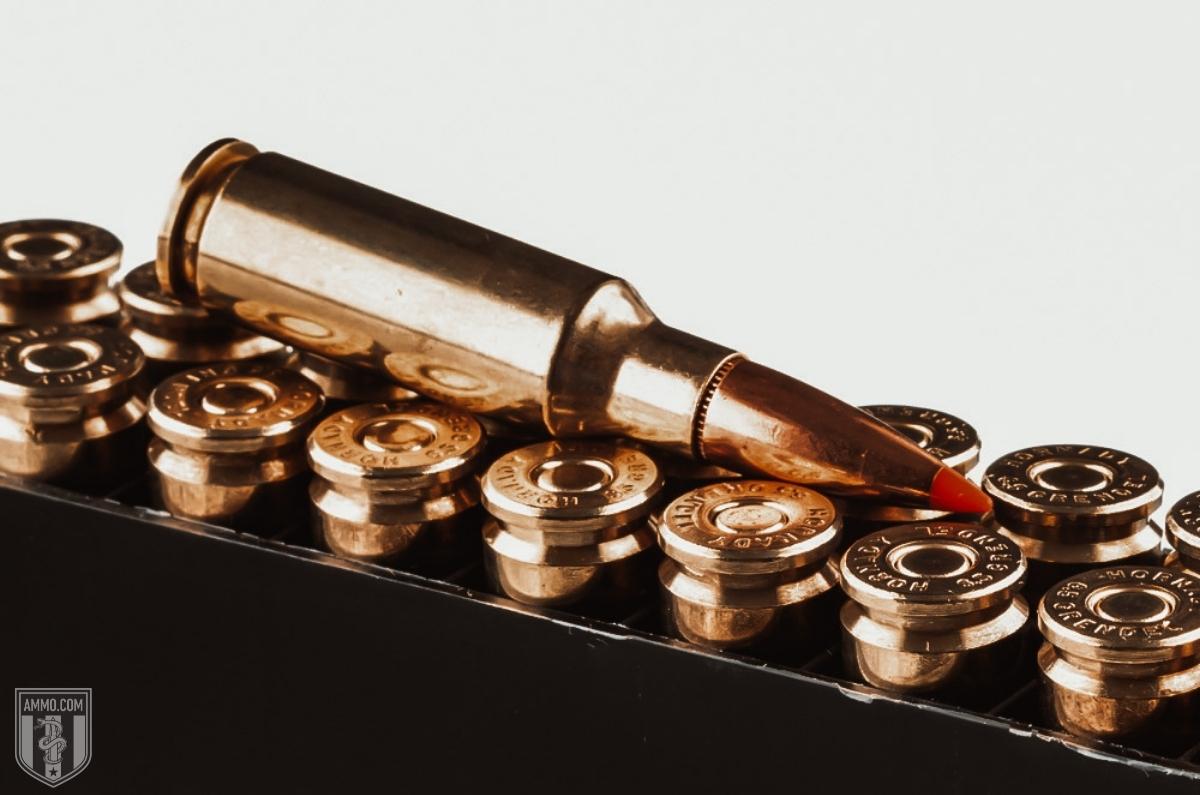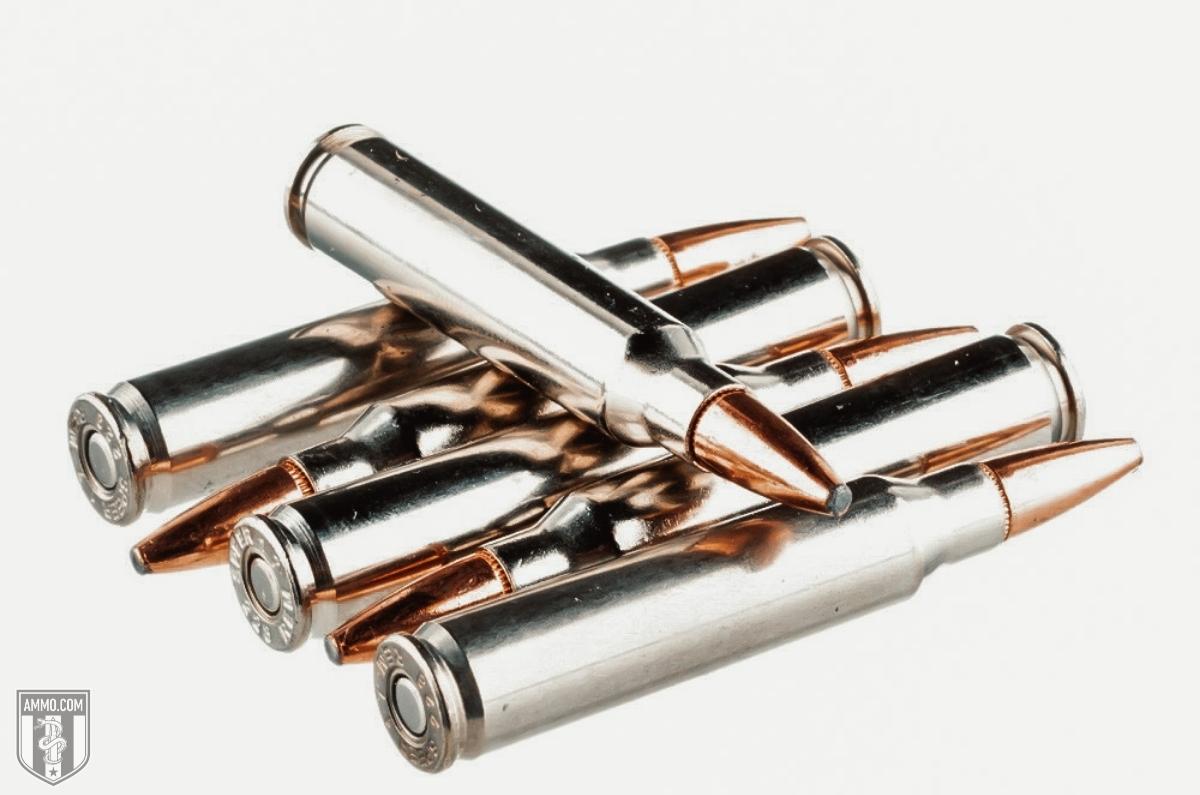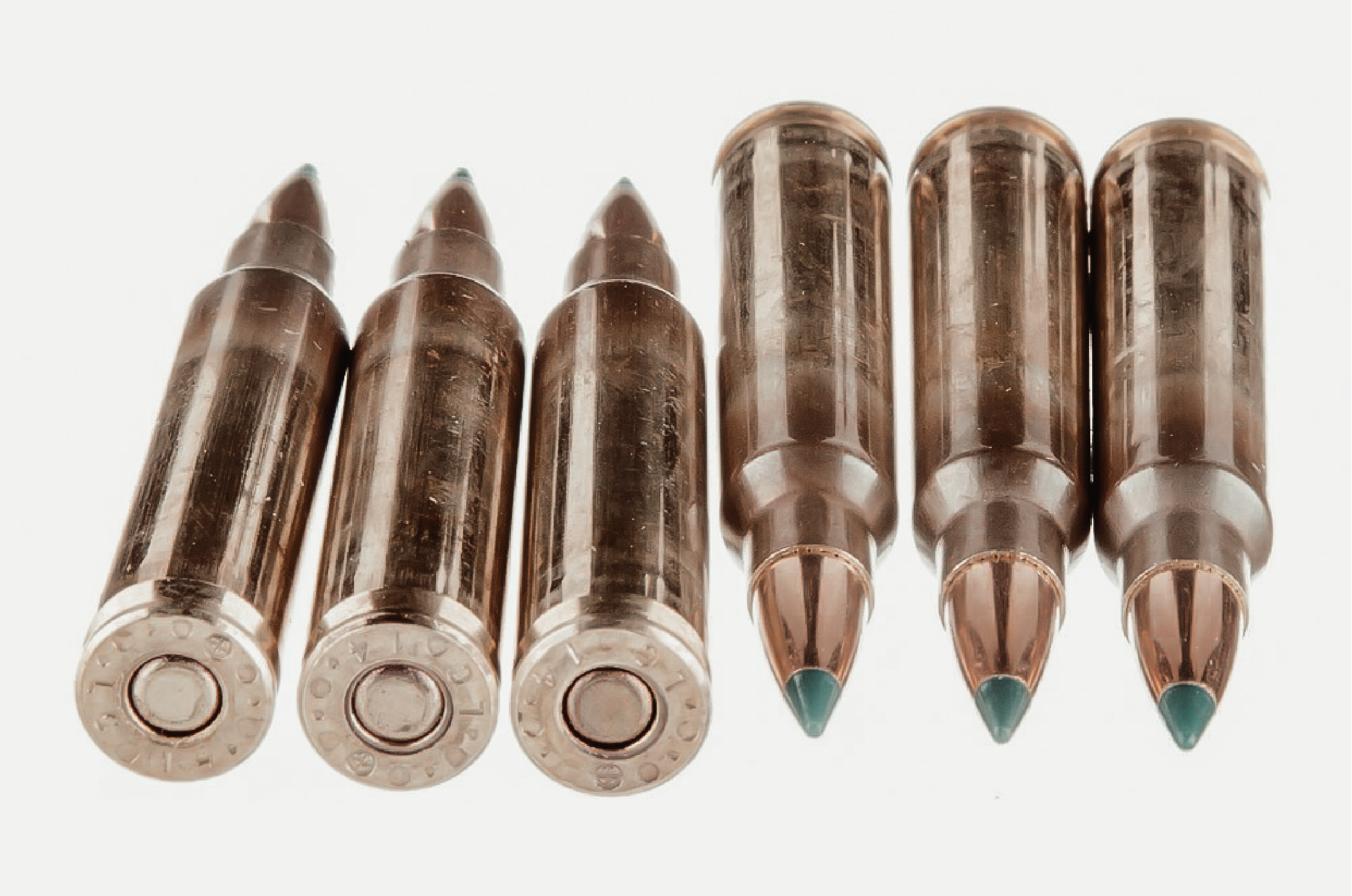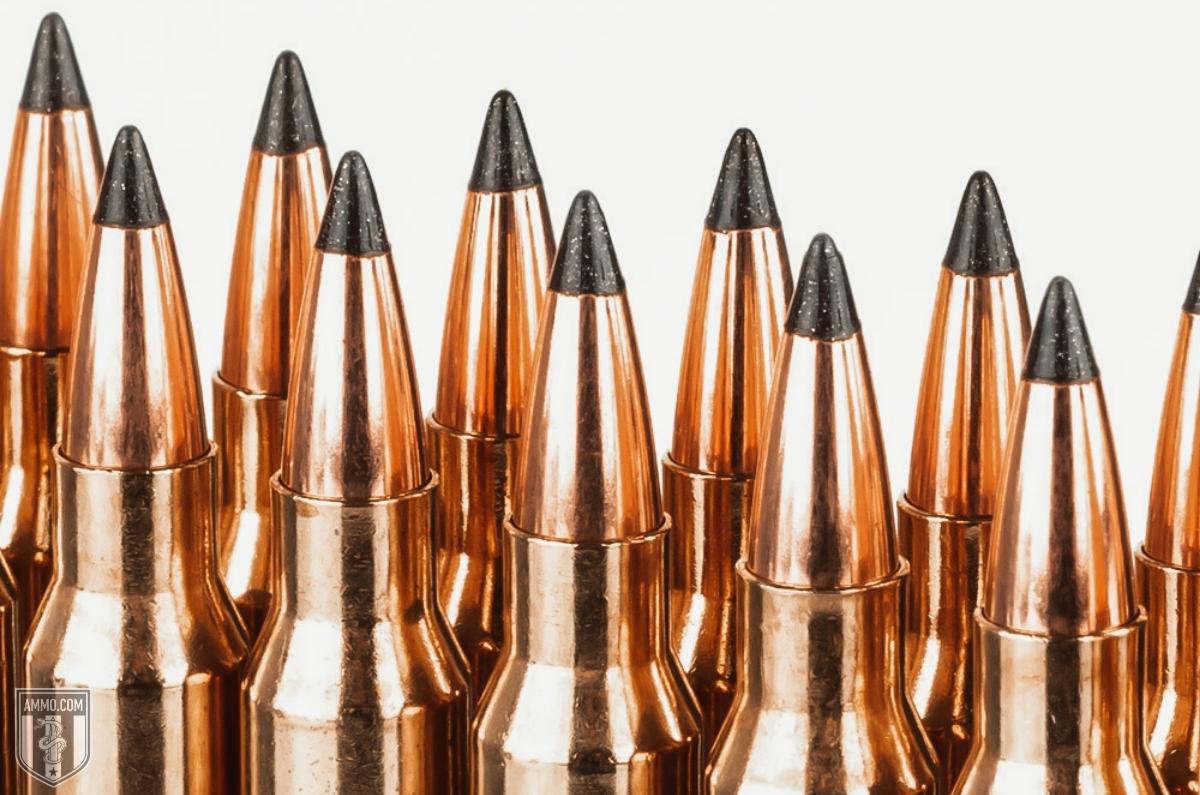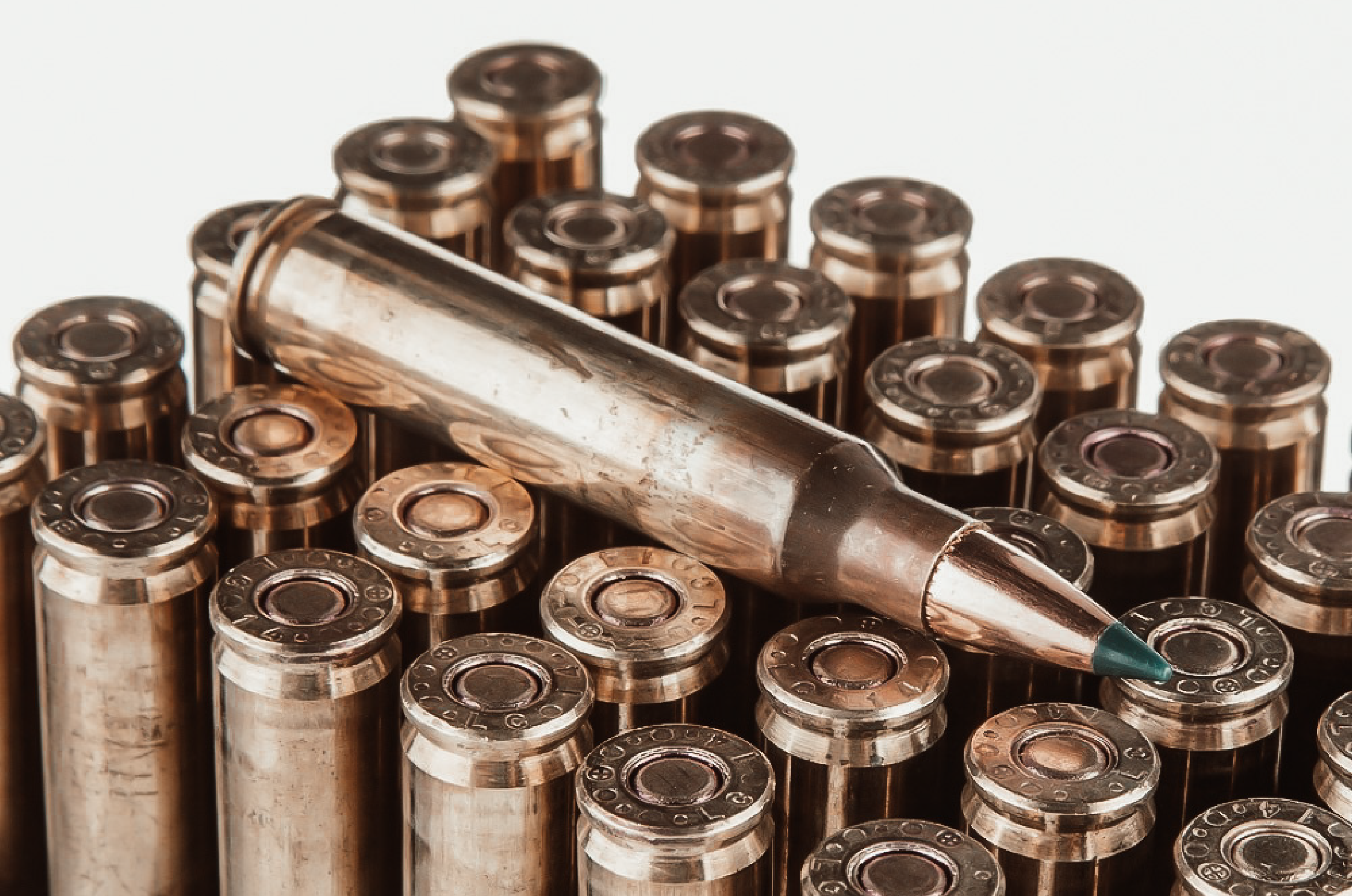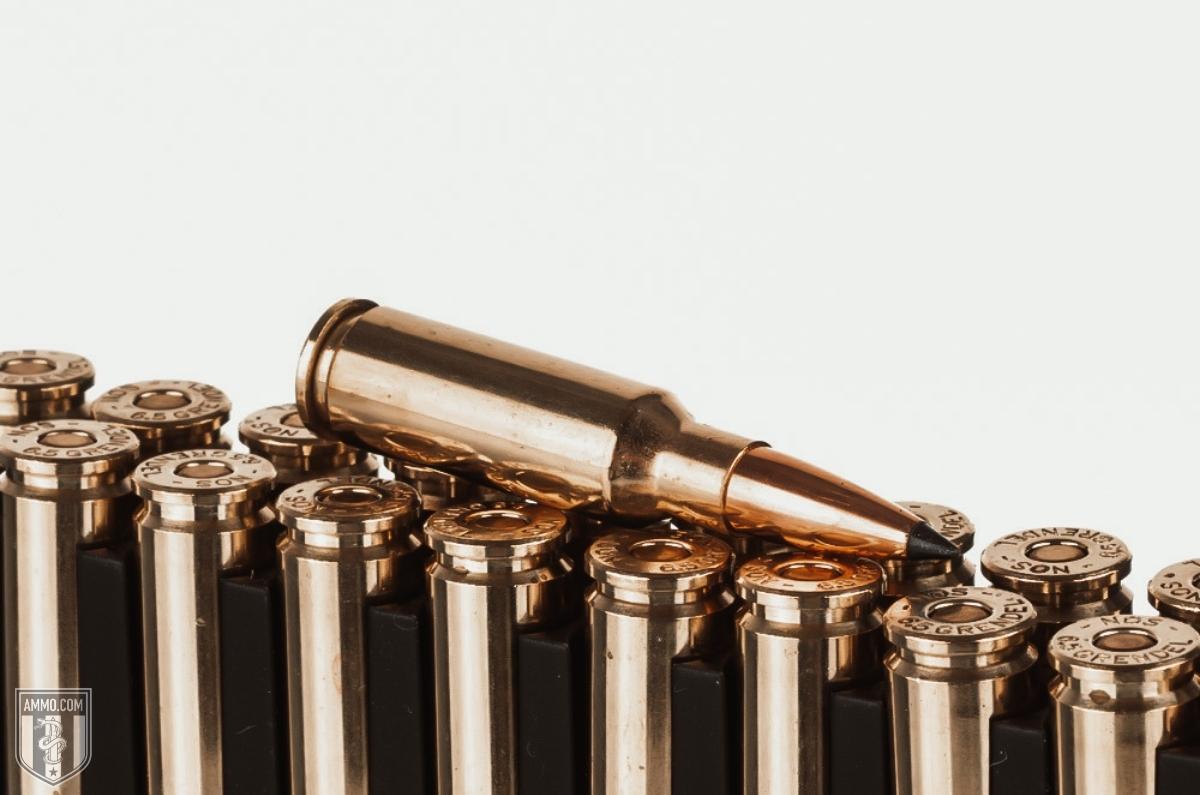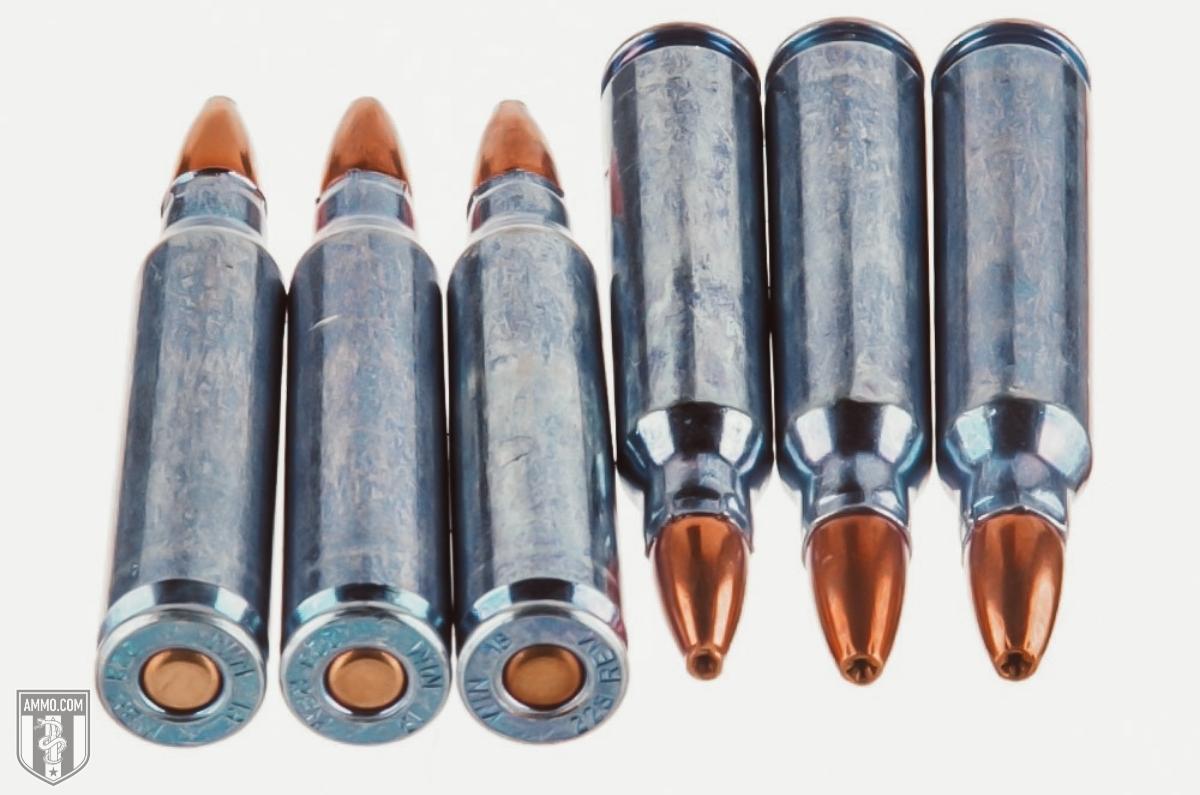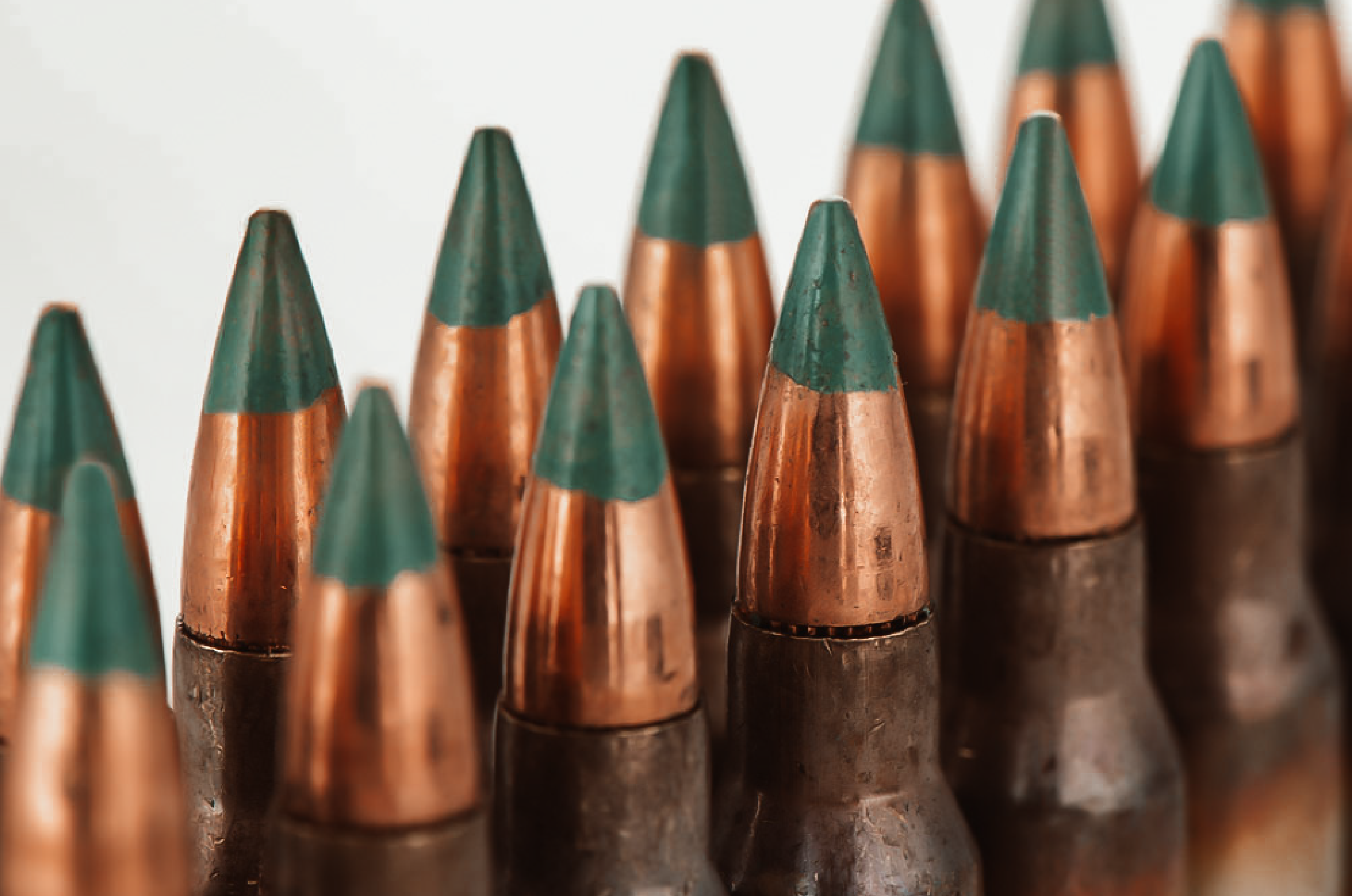6.5 Grendel vs 5.56 vs 223: Extending Your AR-15's Effective Range
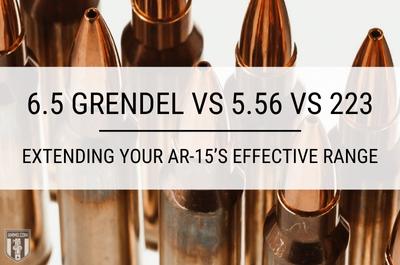 When it comes to the AR-15 semi-automatic rifle, there is no denying that the 223 Remington and 5.56x45mm NATO are the kings of the centerfire cartridges. As it is the standard issue ammo for the U.S. military and an incredibly potent varmint round, the 5.56/223 Rem is by far the most popular centerfire rifle cartridge in North America.
When it comes to the AR-15 semi-automatic rifle, there is no denying that the 223 Remington and 5.56x45mm NATO are the kings of the centerfire cartridges. As it is the standard issue ammo for the U.S. military and an incredibly potent varmint round, the 5.56/223 Rem is by far the most popular centerfire rifle cartridge in North America.
Even though the 223 and 5.56 are both battle-proven rounds, some shooters wanted more out of their AR-15. They wanted more power and range without having to upgrade to the heavier and more expensive AR-10 platform.
Adapting new cartridges to the AR-15 platform is nothing new, as the 6.8 Remington SPC, 300 AAC Blackout, 224 Valkyrie, and 50 Beowulf have all seen moderate acceptance in the AR shooting community.
Enter the 6.5 Grendel cartridge, which gave shooters the range and stopping power they wanted in their lightweight modern sporting rifles.
But is it worth it to upgrade your AR-15 or buy a new one in 6.5 Grendel or should you stick with the tried-and-true 223/5.56 NATO?
In this article we will take a detailed look at the 6.5 Grendel vs 5.56 vs 223 Rem caliber debate and help you understand the advantages that each rifle cartridge has to offer.
What is the difference between 6.5 Grendel, 5.56 and the 223?
The 5.56 and 223 have identical external dimensions and fire the same bullets, but the 5.56 can fire higher pressure loads. The primary difference between 6.5 Grendel and 223/5.56 is the bullet diameter each cartridge fires and the cartridge case design. The 223 and 5.56 fire a 0.224” diameter bullet compared to 0.264” for 6.5 Grendel.
A Note on Nomenclature
The 223 Remington (223 Rem) and the 5.56x45mm NATO have identical external dimensions and are often considered interchangeable. However, there are differences between the two and you can read about them in this article: .223 vs 5.56
In short, a 223 Rem can safely be fired from a rifle or handgun chambered in 5.56, however the opposite is not true as the 5.56 chamber can handle higher pressures than the 223 Rem.
Cartridge Specs
When evaluating centerfire rifle cartridges, it’s a good idea to analyze the cartridge specs to gain more knowledge of each.
The biggest difference between 223/5.56 and 6.5 Grendel is the bullet that each cartridge fires. The 5.56 fires a 0.224” bullet diameter compared to 0.264” (6.5mm) for the Grendel round. This directly affects the bullet weight that each cartridge can fire. 6.5 Grendel ammo typically fires bullets between 90 and 130 grains, with 100, 110, and 123 grain bullets being the most popular. In contrast, the 5.56 fires between 35 and 77 grain bullets with 55 and 62 gr the easiest to find on sporting goods store shelves.
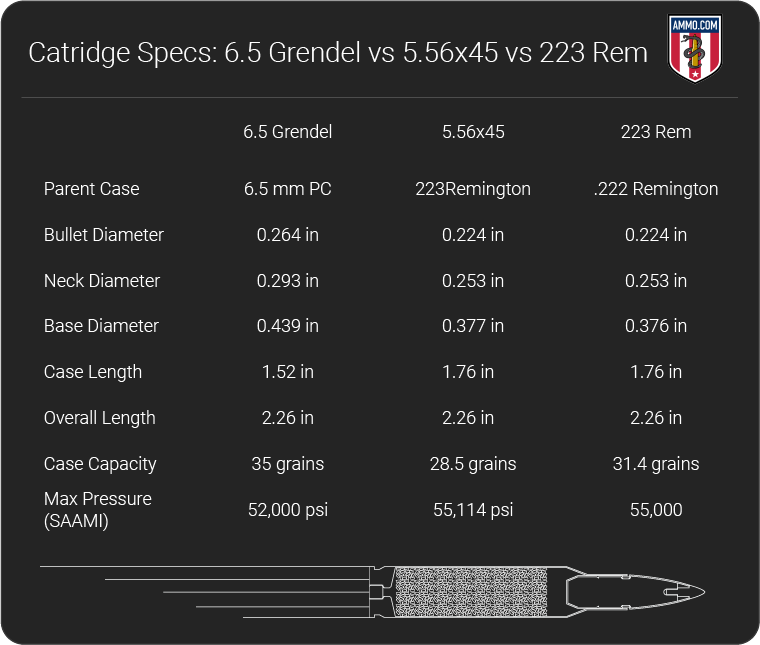
One striking difference between the two rifle cartridges is their case length and width. The 5.56 round is thinner and longer with a base diameter of 0.377” and case length of 1.76”. In comparison, the 6.5 has a base diameter of 0.439” and case length of 1.52”
However, to fit into standard NATO magazines, both the 223, 5.56, and 6.5 Grendel have the same overall length of 2.26”.
Although the 5.56 case is longer, the added width of the 6.5 Grendel case gives it an edge in case capacity, being able to house 35 gr of propellant compared to 28.5 gr for 5.56.
The final difference between the 3 cartridges is the amount of pressure each can withstand. Of the three cartridges, the 5.56 is rated to handle the highest chamber pressure of 55,114 psi, followed closely you 223 Remington at 55,000 psi, and lastly 6.5 Grendel at 52,000 psi.
Recoil
The 223 Remington and 5.56 NATO are well known for being low-recoil rounds.
Recoil is an important consideration when purchasing a new rifle as a round with heavy recoil will be more difficult to control and will slow your rate of follow up shots.
Recoil is affected primarily by muzzle velocity (FPS), bullet weight, and rifle weight.
As the 6.5 Grendel fires heavier bullets, it will have more free recoil than the 223/5.56.
The 223 Rem and 5.56 have an average of 4-4.5 ft-lbs of free recoil energy while the 6.5 Grendel will have around 9 ft-lbs.
On paper that might seem like a huge difference as the 6.5mm Grendel has double the recoil of the 223/5.56. However, most all shooters would not consider the recoil of the 6.5 oppressive by any stretch of the imagination.
It’s true that the 223 and 5.56 have less recoil, but most all shooters will have zero issues spending all day at the range shooting either cartridge.
Muzzle Velocity and Kinetic Energy
When it comes to muzzle velocity, there are only a handful of rounds that are faster than the 223/5.56 NATO. However, they cannot keep up with the 6.5 Grendel in terms of muzzle energy.
For this example, we will compare three rounds from Hornady. For 5.56 we will consider the Frontier 55 gr FMJ (M193 clone), for 223 Remington the 55 gr V-MAX Varmint Express, and for 6.5 Grendel the 123 gr SST. All three rounds are excellent options for target shooting or self-defense.
At the muzzle, the 223 and 5.56 rounds are blazing down range at 3,240 fps compared to 2,580 fps for the Grendel bullet. Although this is only one example, essentially every 223 and 5.56 factory load will have a higher muzzle velocity than the 6.5 Grendel since the 223/5.56 is firing lighter bullets.
However fast the 223 and 5.56 bullets might be, the 6.5 Grendel is firing heavier projectiles that carry a lot more muzzle energy. At the muzzle, the 6.5 Grendel bullet delivers a bone-crushing 1,818 ft-lbs of kinetic energy compared to 1,282 ft-lbs for the 223/5.56.
The disparity between 223/5.56 and 6.5 Grendel clearly illustrates the design concept differences for each rifle cartridge.
The 223 Rem and 5.56 NATO are designed to be an incredibly high velocity, low-recoil round relying on bullet fragmentation and hydrostatic shock while the 6.5 Grendel is designed to impart larger amounts of kinetic energy into the target with a heavier bullet.
It should also be noted that barrel length plays a huge part in muzzle energy and velocity, and that manufacturers often quote their ballistic data from proofing barrels. Typically, 20” barrels are used for 223/5.56 ammo while 24” barrels are used for 6.5 Grendel. If you prefer a shorter barrel length in your AR-15 carbine, understand that your downrange ballistics may vary from the numbers quoted above.
Trajectory
Trajectory is how we quantify a bullet’s flight path as it travels downrange measured in inches of bullet drop.
Obviously, a flatter shooting cartridge is preferred for long-range shooting, as a shooter will require fewer adjustments to their optics to compensate for bullet drop. Having a flatter trajectory also means that a cartridge will be more forgiving of ranging mistakes.
Using the three Hornady factory loads mentioned in the previous section, the 223/5.56 will have a flatter trajectory than the 6.5 Grendel out to 700 yards. This flat trajectory is mostly due to the extremely high muzzle velocity of the 5.56.
To put this into context, at 500 yards the 223 and 5.56 will experience around -53” and -55” of bullet drop, respectively, compared to -64” for the 6.5 Grendel bullet.
For 223 and 5.56, 500 yards is generally considered the maximum effective range as the bullet will drop below the recommended 220 ft-lbs of kinetic energy for combat effectiveness near this point. Furthermore, the 223/5.56 will drop below subsonic speeds around 700 yards, at which point its trajectory suffers even more.
On the other hand, at 700 yards the 6.5 Grendel is still well above the supersonic limit and can maintain over 220 ft-lbs of energy past 1,000 yards.
When it comes to long range shooting over 600 yards, the 6.5 Grendel is clearly the better option.
However, for shots under 600 yards, the 223 and 5.56 has a flatter trajectory and enough kinetic energy to get the job done.
Ballistic Coefficient
Ballistic coefficient (BC) is a measure of how well a bullet resists wind drift and air resistance. Put another way, it’s a numeric representation of how aerodynamic a bullet is. A high BC is preferred as this means the bullet will buck the wind easier.
Generally, heavy bullets will have a higher BC as it takes more force to disrupt the flight of a heavier bullet than a lighter one. Ballistic coefficient varies from bullet to bullet based on design, weight, and other factors that are beyond the scope of this article.
As the 6.5mm Grendel round fires heavier bullets, it will normally have a higher ballistic coefficient than 5.56 NATO or 223 Remington.
The 6.5mm bullet designs are right in the sweet spot when it comes to ballistic coefficient. They are long, aerodynamic, and streamlined, making for an extremely wind resistant package. This is one reason for the increased popularity of the 6.5 Creedmoor round for long-distance shooting.
The 123 gr Hornady SST 6.5mm bullet has a BC of 0.510, for 5.56 one of the better options is the Hornady ELD Match 73 gr bullet with a BC of 0.398.
Using these two bullets as an example, with a 10 mph cross wind, the 123 gr SST will have 20” of wind drift compared to 25” for the ELD match bullet.
In terms of ballistic coefficient, the 6.5 Grendel is the clear winner.
Sectional Density
Sectional Density (SD) is the measure of how well a bullet penetrates a target. This is extremely important when hunting big and medium sized game, as you need a bullet that can punch through thick hide, bone, and sinew.
Sectional density is calculated by comparing the bullet weight and the bullet diameter. The higher the SD the deeper the bullet will penetrate into the target. This is a simplified view of penetration as there are other factors to consider, such as bullet expansion and high velocity.
The 6.5 Grendel dominates in terms of penetration, as its heavier bullets punch deeper into the target with their higher kinetic energy.
Although the 223/5.56 focuses all its velocity into a small surface area, the 6.5 just hits harder and penetrates deeper. The average sectional density for 6.5 Grendel is around 0.252 while only the heavy hitting 73 gr ELD Match or 75 gr InterLock bullets achieve a SD around 0.210 for 5.56. The more common 55 gr loads carry a sectional density of 0.157.
The 6.5 Grendel is clearly the better option when deeper penetration is required, like in big game hunting.
Hunting
In terms of hunting, both rifle cartridges excel in their respective areas of expertise.
The 5.56 NATO/223 Rem is an awesome choice for varmint hunting, where the flatter trajectory makes it a great choice for longer range shots. However, both the 223 and 5.56 lack the kinetic energy needed to ethically harvest medium to large sized game like whitetail. Many states and provinces prohibit the use of 0.224” diameter bullets for deer hunting due to this.
This is where the 6.5 Grendel really shines, as its heavier bullets pack enough power to harvest a deer or antelope up to a range of around 400 yards. Although you could use the 6.5mm Grendel for varmint hunting, most shooters prefer the low recoil and lighter bullets fired from the 223 or 5.56 for this purpose.
Technically the 6.5 could be used to take an elk within 100 yards if your shot placement is perfect, however something along the lines of a 300 Winchester Magnum would be preferred for large game like this.
The bottom line is that 223/5.56 is an excellent varmint cartridge with its lightweight bullets and flat trajectory, while the 6.5 is preferred for deer-sized game animals.
Ammo and Rifle Cost/Availability
The 223/5.56 NATO cannot be beat in terms of ammo availability and price.
Virtually every ammo manufacturer has multiple factory loads for both 223 Rem and/or 5.56 NATO. As this is the frontline cartridge used by the U.S. military, there are also a plethora of surplus ammo options available on the market.
The popularity of the 5.56 really helps keep prices down and supply up. You can find 223/5.56 ammo virtually anywhere that ammunition is sold. Don't miss out on our Winchester 5.56 ammo deals.
Although the 6.5 Grendel is a very potent cartridge, it has not seen widespread adoption like that of the 223/5.56 or even the 300 Blackout. This was, in part, due to some poor marketing decisions at Alexander Arms in keeping the Grendel design trademarked, and therefore delaying standardization by SAAMI.
In terms of ammo variety, the 223 and 5.56 dominates the 6.5 Grendel to the tune of a 3:1 advantage.
And remember, buying in bulk is always smart, make sure to check out our stock of bulk 223 ammo and 5.56 bulk ammo.
Ammo prices for 223 and 5.56 NATO are essentially identical. Inexpensive FMJ 5.56 ammo costs around $0.60/round while match-grade ammo usually runs around the tune of $1.50/round and up depending on bullet weight and manufacturer.
For the 6.5 Grendel, “inexpensive” and “ammo” rarely go in the same sentence together. Wolf recently began offering steel-cased 6.5 Grendel ammo around $1/round, but other FMJ ammo from Hornady or Federal will typically start around $1.60/round. As far as premium hunting Grendel ammo is concerned, you should expect to pay no less than $2.20/round and go up from there.
In terms of rifle availability, the AR-15 platform is the most popular semi-automatic rifle in North America and the most popular chambering is unquestionably 5.56x45mm NATO. However, as the AR-15 can easily be converted to fire 6.5 Grendel by changing the barrel, bolt, and magazine, this means virtually any AR platform can be the host for 6.5.
For bolt-action rifles, there are a few options available for 6.5 Grendel. The Ruger American Predator is by far the most common bolt action rifle for the Grendel, but you can also pick up a Howa M1500 or CZ527 for all your bolt-action Grendel needs.
When looking for a bolt-action 5.56 rifle, you’ll quickly discover that most of them are chambered in 223 Rem and not 5.56. As the 223 Remington is marketed primarily as a varmint round, it holds a very large market share in the bolt-action rifle space. However, remember that it is not safe to fire 5.56 ammo in a 223 rifle as we discuss in this article HERE.
If you really want a bolt action rifle in 5.56, there are a few options available like the Ruger American Ranch, the Ruger GUNSITE Scout, and Mossberg MVP Patrol.
Reloading
When it comes to 223/5.56 NATO and 6.5 Grendel, reloading is one option that many shooters utilize to reduce their cost per round.
As inexpensive military surplus brass, powder, and bullets are easy to find for 5.56, it is a rifle cartridge that many handloaders enjoy reloading in bulk.
One thing to note, there are no reloading dies specific for 5.56 NATO. The 223 Remington is dimensionally identical to the 5.56, only 223 Rem dies are available.
Sourcing 6.5 Grendel brass can be a bit more problematic as it is not as popular as 5.56. However, there are still many options available for factory new or once-fired brass on the secondary market. Bullets, on the other hand, are relatively plentiful due to the success of the 6.5 Creedmoor.
Ballistics: 5.56 vs 6.5 Grendel vs 223 Remington
Our team here at Ammo.com has spent countless hours scouring the Internet to bring you extremely comprehensive ballistics tables for both calibers. Below are tables that compare bullet weight to muzzle velocity, kinetic energy, and trajectory for both 6.5 Grendel vs 5.56 vs 223.
6.5 Grendel Ballistics
Note: This information comes from the manufacturer and is for informational purposes only. The actual ballistics obtained with your firearm can vary considerably from the advertised ballistics. Also, ballistics can vary from lot to lot with the same brand and type load.
| 6.5mm Grendel Bullet WEIGHT | Muzzle VELOCITY (fps) | Muzzle ENERGY (ft. lbs.) | TRAJECTORY (in.) | |||||||||||
|---|---|---|---|---|---|---|---|---|---|---|---|---|---|---|
| Muzzle | 100 yds. | 200 yds. | 300 yds. | 400 yds. | Muzzle | 100 yds. | 200 yds. | 300 yds. | 400 yds. | 100 yds. | 200 yds. | 300 yds. | 400 yds. | |
| 123 Grain | 2590 | 2420 | 2256 | 2099 | 1948 | 1832 | 1599 | 1390 | 1203 | 1037 | 1.8 | 0 | -8.6 | -25.1 |
5.56 NATO Ballistics
Note: This information comes from the manufacturer and is for informational purposes only. The actual ballistics obtained with your firearm can vary considerably from the advertised ballistics. Also, ballistics can vary from lot to lot with the same brand and type load.
| 5.56x45mm Bullet WEIGHT | Muzzle VELOCITY (fps) | Muzzle ENERGY (ft. lbs.) | TRAJECTORY (in.) | |||||||||||
|---|---|---|---|---|---|---|---|---|---|---|---|---|---|---|
| Muzzle | 100 yds. | 200 yds. | 300 yds. | 400 yds. | Muzzle | 100 yds. | 200 yds. | 300 yds. | 400 yds. | 100 yds. | 200 yds. | 300 yds. | 400 yds. | |
| 55 Grain NATO | 3130 | 2740 | 2382 | 2051 | 1750 | 1196 | 917 | 693 | 514 | 372 | 1.1 | 0 | -7.3 | -23 |
| 75 Grain NATO | 2910 | 2676 | 2543 | 2242 | 2041 | 1410 | 1192 | 1002 | 837 | 693 | 1.2 | 0 | -7 | -21 |
223 Remington Ballistics
Note: This information comes from the manufacturer and is for informational purposes only. The actual ballistics obtained with your firearm can vary considerably from the advertised ballistics. Also, ballistics can vary from lot to lot with the same brand and type load.
| 223 Bullet WEIGHT | Muzzle VELOCITY (fps) | Muzzle ENERGY (ft. lbs.) | TRAJECTORY (in.) | |||||||||||
|---|---|---|---|---|---|---|---|---|---|---|---|---|---|---|
| Muzzle | 100 yds. | 200 yds. | 300 yds. | 400 yds. | Muzzle | 100 yds. | 200 yds. | 300 yds. | 400 yds. | 100 yds. | 200 yds. | 300 yds. | 400 yds. | |
| 35 Grain | 3750 | 3206 | 2725 | 2291 | 1899 | 1092 | 799 | 577 | 408 | 280 | 1 | 0 | -5.7 | -18.1 |
| 35 Grain | 4000 | 3353 | 2796 | 2302 | 1861 | 1243 | 874 | 607 | 412 | 269 | 0.8 | 0 | -5.3 | -17.3 |
| 40 Grain | 3650 | 3010 | 2450 | 1950 | 1530 | 1185 | 805 | 535 | 340 | 265 | 2 | 1 | -6 | -22 |
| 40 Grain | 3800 | 3305 | 2845 | 2424 | 2044 | 1282 | 970 | 719 | 522 | 371 | 0.84 | 0 | -5.34 | -16.6 |
| 45 Grain Green | 3550 | 2911 | 2355 | 1865 | 1451 | 1259 | 847 | 554 | 347 | 210 | 2.5 | 2.3 | -4.3 | -21.1 |
| 50 Grain | 3300 | 2874 | 2484 | 2130 | 1809 | 1209 | 917 | 685 | 504 | 363 | 1.37 | 0 | -7.05 | -21.8 |
| 52 Grain | 3330 | 2882 | 2477 | 2106 | 1770 | 1305 | 978 | 722 | 522 | 369 | 2 | 0.6 | -6.5 | -21.5 |
| 53 Grain | 3330 | 2882 | 2477 | 2106 | 1770 | 1305 | 978 | 722 | 522 | 369 | 2 | 0.6 | -6.5 | -21.5 |
| 55 Grain Green | 3240 | 2747 | 2304 | 1905 | 1554 | 1282 | 921 | 648 | 443 | 295 | 1.9 | 0 | -8.5 | -26.7 |
| 55 Grain | 3240 | 2748 | 2305 | 1906 | 1556 | 1282 | 922 | 649 | 444 | 296 | 2 | -0.2 | -9 | -27 |
| 60 Grain | 3100 | 2712 | 2355 | 2026 | 1726 | 1280 | 979 | 739 | 547 | 397 | 2 | 0.2 | -8 | -24.7 |
| 62 Grain | 3000 | 2700 | 2410 | 2150 | 1900 | 1240 | 1000 | 800 | 635 | 495 | 1.6 | 0 | -7.7 | -22.8 |
| 64 Grain | 2750 | 2368 | 2018 | 1701 | 1427 | 1074 | 796 | 578 | 411 | 289 | 2.4 | 0 | -11 | -34.1 |
| 64 Grain | 3020 | 2621 | 2256 | 1920 | 1619 | 1296 | 977 | 723 | 524 | 373 | 2 | -0.2 | -9.3 | -23 |
| 64 Grain | 3020 | 2621 | 2256 | 1920 | 1619 | 1296 | 977 | 723 | 524 | 373 | 2 | -0.2 | -9.3 | -23 |
| 69 Grain | 3000 | 2720 | 2460 | 2210 | 1980 | 1380 | 1135 | 925 | 750 | 600 | 2 | 0.8 | -5.8 | -17.5 |
| 75 Grain | 2790 | 2554 | 2330 | 2119 | 1926 | 1296 | 1086 | 904 | 747 | 617 | 2.37 | 0 | -8.75 | -25.1 |
| 75 Grain | 2790 | 2562 | 2345 | 2139 | 1943 | 1296 | 1093 | 916 | 762 | 629 | 1.5 | 0 | -8.2 | -24.1 |
| 75 Grain | 2790 | 2562 | 2345 | 2139 | 1943 | 1296 | 1093 | 916 | 762 | 629 | 1.5 | 0 | -8.2 | -24.1 |
| 75 Grain Super Match | 2930 | 2694 | 2470 | 2257 | 2055 | 1429 | 1209 | 1016 | 848 | 703 | 1.2 | 0 | -6.9 | -20.7 |
| 77 Grain | 2750 | 2584 | 2354 | 2169 | 1992 | 1293 | 1110 | 948 | 804 | 679 | 1.93 | 0 | -8.2 | -23.8 |
A Brief History of 6.5 Grendel
Ever since the adoption of the 223 Remington/5.56 NATO cartridge by the US armed forces, critics have questioned the combat effectiveness and terminal ballistics of the 22-caliber round. As a result, several intermediate cartridges have been adapted to the AR-15 platform such as the 300 Blackout and 6.8 SPC in an attempt to bridge the gap between the 223 Remington and 308 Winchester.
Never one to back down from a challenge, British/American armorer Bill Alexander of Alexander Arms debuted the 6.5 Grendel in May 2003 at the Blackwater training facility in North Carolina. Alexander Arms also utilized the services of competitive shooter Arne Brennan and senior ballistician Janne Pohjoispää of Lapua in development of the new rifle cartridge.
Bill Alexander was clearly a fan of mythology, as Grendel is the name of a monster in the British epic poem, Beowulf. Staying true to form, Alexander Arms also developed the 50 Beowulf cartridge for the AR-15 as well.
The goal of the 6.5 Grendel was to develop an intermediate cartridge that extended the effective range of AR-15 rifles out past 800 yards. Utilizing the same higher ballistic coefficient 0.264” diameter bullets used by the 6.5 Creedmoor, the 6.5 Grendel is capable or maintaining MOA-level accuracy and supersonic velocities out to 1,200 yards with half the recoil of the 308 Win.
Descended from the 6.5mm PPC, which itself was developed from the 220 Russian and 7.62x39mm, the 6.5 Grendel has a wider case head than the 223 Remington and requires a non-standard AR-15 bolt and specialized magazines for use in AR-15 rifles.
Wide-spread adoption of the 6.5 Grendel was somewhat hindered by Bill Alexander himself, as he insisted that the cartridge be trademarked, and therefore could not be standardized by SAAMI. However, Alexander Arms in collaboration with Hornady Ammunition, registered the 6.5 Grendel with SAAMI in 2010. This allowed other manufacturers to create and sell 6.5 Grendel ammo, greatly expanding the reach of the cartridge.
As the 6.5 Grendel is still a relatively new cartridge on the market, it has developed a stalwart following in the shooting community who enjoy the terminal ballistics of a 308 Win without having to upgrade to an AR-10.
Although the 6.5 Grendel has not yet been adopted by the US military, the Serbian military is currently conducting tests in accordance with adopting the 6.5 Grendel in their new M17 Zastava battle rifles.
With exceptional long range capability, barrel life, and MOA-level accuracy, the 6.5 Grendel is an excellent choice if you’re looking to upgrade your AR-15 platform to something that has a bit more stopping power than a 223 Rem.
To read more about the 6.5 Grendel, check out the full history of the cartridge on our 6.5 Grendel history page.
If you’d like to learn more about how the 6.5 Grendel compares to other calibers, check out these articles below:
A Brief History of 223 Remington and 5.56 NATO
After the Korean War, the U.S. Military started designing a new rifle cartridge for its frontline service rifles. And in 1954 the 308 Winchester (7.62x51mm NATO) was adopted to fill this role.
However, after early engagements in Vietnam, the U.S. Army wanted a new rifle that fired a lighter, intermediate cartridge like the AK-47. This would allow their soldiers to carry more ammo into battle while maintaining powerful terminal ballistics to remain combat effective.
This was the beginning of the 223 Remington.
Development of the 223 Rem rifle round began in 1957 and the final design was submitted by Remington Arms to the Sporting Arms and Ammunition Manufacturers' Institute (SAAMI) in 1962.
The development of the 223 Remington cartridge was a joint operation organized by the U.S. Continental Army Command between Fairchild Industries, Remington Arms, and Eugene Stoner of Armalite, using the 222 Remington as a parent cartridge.
The original 223 Rem mil-spec ammo that the U.S. Military adopted was named M193, which fired a 55 gr full metal jacket (FMJ) bullet at a muzzle velocity of 3260 FPS with a muzzle energy of 1294 foot-pounds.
The M193 cartridge served the U.S. Army all the way through Vietnam, however, FN Herstal changed the game in the several years later.
In 1980, the Belgian firearms and cartridge manufacturer Fabrique Nationale (FN) Herstal submitted their designs for the SS109 5.56x45mm cartridge to NATO for approval. The SS109 fires a 62-grain FMJ bullet with a mild steel penetrator tip at 3,110 fps and has a muzzle energy of 1,325 ft-lbs.
The U.S. Military designation for the 5.56mm NATO SS109 is the M855.
The new 5.56mm NATO cartridge had identical external dimensions to the 223 Remington, however the NATO cartridge can handle a higher maximum pressure.
Although, as with many things in life, sometimes the newer, shinier toy is not always the best.
The adoption of the SS109 NATO round has come under some criticism due to battlefield reports of the ineffectiveness of the 5.56’s stopping power, accuracy, and effective range. This has led to several advancements in 5.56mm NATO ammunition.
One of the biggest criticisms of the SS109 NATO cartridge was its inability to yaw (tumble) and fragment. The M193 was well known for tumbling and fragmenting upon entry into soft tissue, causing additional damage to the target.
The Mk 262 was the next iteration of the 5.56mm NATO round was one that fired a 77 gr OTM (open tip match) bullet designed for the Mk 12 SPR (squad precision rifle). Special Forces became fond of the MK 262 as it offered better terminal ballistics in the M4 carbines than what was observed with the SS109 NATO rounds. However, the Mk 262 was not adopted for widespread use due to the increased cost of heavier OTM bullets.
The Mk 318 was the next 5.56mm NATO cartridge evolution that used an open tip design to facilitate soft tissue damage and a solid brass penetrator base for added barrier penetration. This allows it to be employed against targets with or without body armor. Furthermore, the Mk 318 will fragment upon impact and is not dependent bullet yaw (tumbling) like the M193 and M855.
The most recent iteration of the 5.56mm NATO round is the M855A1 (ingenious naming, I know!) And the reason for its development is even more awe-inspiring to say the least.
The M855A1 was developed because the U.S. Military wanted to go “greener” and move away from lead-core bullets.
However, all environmental jokes aside, the M855A1 proved to have several distinct advantages over traditional M855 ammo. It was slightly more accurate, provided improved terminal ballistics and wounding capacity, as well as increased barrier penetration.
The M855A1 fires a 62 grain FMJ bullet with a solid copper core and steel penetrator tip extending past the jacket and has been in service since 2010.
To read more about the 5.56 NATO and 223 Remington, check out the full history of the cartridge on our 5.56 NATO history page and 223 Remington history page.
If you’d like to learn more about how the 5.56 compares to other calibers, check out these articles below:
Final Shots: 6.5 Grendel vs 5.56
When it comes to choosing the 223 vs 5.56 vs 6.5 Grendel for your next AR-15 or modern sporting rifle, there are several factors to consider.
The 6.5 Grendel is an excellent choice for long range shooting or medium sized game hunting. Its powerful 6.5mm bullet has amazing external and terminal ballistics that give it a longer effective range than the 5.56 at the cost of more recoil and higher ammo prices.
On the other hand, the 5.56 NATO is an exceptional varmint round with a flatter trajectory and lower recoil than the Grendel cartridge as well as a lower cost per round.
Most shooters will opt for the 5.56 NATO as AR-15 rifles are easy to find, inexpensive, and you can fire both 223 Rem and 5.56 out of it, giving added versatility. However, if you need something for longer range shots or you want to deer hunt with your AR-15, then the 6.5 Grendel is an excellent option.
No matter which cartridge you choose, make sure to get all of your ammo here at Ammo.com and I’ll see you out on the range!
Ammo Comparisons
- .308 vs 5.56
- 6.5 Creedmoor vs .308
- .300 Blackout vs .308
- .300 Win Mag vs .308
- .243 vs .308
- .308 vs .30-06
- 7mm-08 vs .308
- .270 vs .308
- 7.62x39 vs .308
- .223 vs .308
- .338 Lapua vs .308
- .380 ACP vs 9mm
- .223 vs 5.56
- .300 Blackout vs 5.56
- 9mm vs 45 ACP
- 9mm vs 40 S&W
- .357 SIG vs 9mm
- 10mm vs 9mm
- 9mm vs 9mm Luger
- .243 vs .270
- .300 Win Mag vs .30-06
- .270 vs .30-06
- .40 vs .45
- 38 Special vs 357
- 9mm vs 40 vs 45
- 5.56 vs 7.62x39
- 338 Lapua vs .30-06
- .30-30 vs .30-06
- 300 PRC vs 338 Lapua
- .30-06 vs 7mm
- 300 Win Mag vs 338 Lapua
- 300 PRC vs 300 Win Mag
- 300 WSM vs 300 Win Mag
- 338 Win Mag vs 338 Lapua
- 12 Gauge vs 20 Gauge
- 10mm vs 357 Mag
- .30-30 vs 7.62x39
- 224 Valkyrie vs 22-250
- 17 HMR vs 22 Mag
- 7.62x39 vs .300 Blackout
- 45 ACP vs 45 Auto
- 45-70 vs 30-30
- 300 Blackout vs 223
- 357 Magnum vs 9mm
- 350 Legend vs 300 Blackout
- 224 Valkyrie vs 223
- 45 ACP vs 38 Super
- 6.5 Grendel vs .308
- 17 HMR vs 22 LR
- 10 Gauge vs 12 Gauge
- 22-250 vs 223
- 45 Colt vs 45 ACP
- 350 Legend vs 30-30
- 5.7x28 vs 223
- 5.7 vs 9mm
- 5.56 vs 5.7
- 22 vs 9mm
- Buckshot vs Birdshot
- 450 Bushmaster vs 308
- 450 Bushmaster vs 223
- Buckshot vs Slug
- 6.5 Grendel vs 5.56 vs 223
- 6mm ARC vs 6.5 Grendel
- 44 vs 45
- 458 SOCOM vs 5.56
- 357 vs 44
- 32 ACP vs 380
- 300 Win Mag vs 338 Win Mag vs 338 Lapua Mag
- 450 Bushmaster vs 458 SOCOM vs 50 Beowulf
- 6mm Creedmoor vs 6.5 Creedmoor
- TMJ vs FMJ
- 44 Special Vs 44 Magnum
- 45 90 vs 45 70
- 6.8 Western vs 6.8 SPC
- 50 Beowulf vs 50 BMG
- 26 Nosler vs 6.5 PRC
- 28 Gauge vs 410
- 6.8 SPC vs 5.56
- 6.8 SPC vs 6.5 Grendel
- 6.8 Western vs 7mm Rem Mag vs .28 Nosler
- 6.8 Western vs 6.5 Creedmoor
- 22 Hornet vs 223
- 6.8 Western vs 6.5 PRC
- .410 vs 12 Gauge
- .410 vs 20 Gauge
- 22 LR vs 22 Mag
- 6mm ARC vs 243
- 7mm-08 vs 270
- 243 vs 6.5 Creedmoor
- Nickel vs Brass Casing
- 204 Ruger vs 223
- 50 Beowulf vs 5.56
- 260 Remington vs 6.5 Creedmoor
- 6mm Remington vs 243
- 28 Nosler vs 300 PRC
- 50 Beowulf vs 50 AE
- 22 Nosler vs 22-250
- 450 Marlin vs 45-70
- 300 Win Mag vs 300 Norma
- 458 SOCOM vs 300 Blackout
- 38-55 vs 45-70
- 22 Hornet vs 22 LR
- 300 Norma vs 338 Lapua
- 338 Lapua vs 50 BMG
- 28 Nosler vs 300 Win Mag
- 28 Nosler vs 6.5 Creedmoor
- 204 vs 22-250
- 458 SOCOM vs 45 70
- 44 40 vs 45 70
- 6.8 SPC vs 6.5 Creedmoor
- 450 Bushmaster vs 30-06
- 7mm Rem Mag vs 300 Win Mag
- 30 Carbine vs 223
- 25-06 vs 30-06
- 26 Nosler vs 28 Nosler
- 16ga vs 12ga
- 30 06 vs 7.62 x54R
- 9mm Makarov vs 9mm Luger
- 350 Legend vs 223
- 30 Carbine vs 5.56
- 6.5x55 vs 6.5 Creedmoor
- 6.5 Creedmoor vs 270 vs 25-06
- M193 vs M855
- 450 Bushmaster vs 458 SOCOM
- 6.5 Grendel vs 6.5 Creedmoor
- 350 Legend vs 5.56
- .277 Fury vs 6.8 SPC
- 277 Fury vs 300 Win Mag
- 10mm vs .45 ACP
- 277 Fury vs 223
- 6.8 SPC vs 300 Blackout
- 6.5 PRC vs 6.5 Creedmoor
- 277 Fury vs 308
- 277 Fury vs 6.5 Creedmoor
- 350 Legend vs 450 Bushmaster
- 277 Fury Vs 5.56 NATO
- 10mm vs 40S&W
- 32 ACP vs 9mm
- 32 Special vs 9mm
- 8.6 Blackout vs 300 Blackout
- 30 Super Carry vs. 9mm
- 5.56 vs 9mm
- .50 Action Express vs 9mm
- 7.62x25 vs. 9mm
- 10mm vs 44 Magnum
- 300 Blackout vs 300 Win Mag
- 6.5 Grendel vs 300 Blackout
- 460 Rowland vs 10mm
- 300 RUM vs 300 PRC
- 300 Norma vs 300 PRC
- 45 GAP vs 45 ACP
- 7mm PRC vs 300 Win Mag
- 300 PRC vs 6.5 Creedmoor
- 300 PRC vs 308
- 357 SIG vs 357 Mag
- 7.62x39 vs 7.62x51
- 243 Win vs 223 Rem
- 30 Nosler vs 300 PRC
- 6.5 Creedmoor vs. 30-06 Springfield
- 450 S&W vs. 44 Magnum
- 6.5 Creedmoor vs. 300 Win Mag
- 454 Cassull vs. 45-70 Govt
- 454 Cassull vs. 44 Mag
- 7.62x54r vs. 308 Winchester
- 22 ARC vs. 223 Rem
